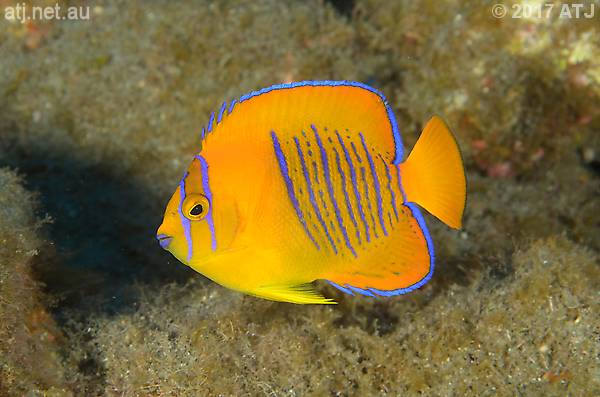
Juvenile Clarion angelfish, Holocanthus clarionensis, at Isla San Beneditco.
As I have done in previous years, here's my review of my diving in 2017. It was another great year of diving. It is almost like each year is better than the previous year but perhaps it is just that the year just finished is fresher in my mind. Sydney diving is so good at the moment but I also got to dive in Mexico and I finally got to South Australia and saw some leafy seadragons for the first time. Yet again I saw some organisms in Sydney for the first time.
I'll cover the statistics first and then move on to the interesting stuff. In 2017 I did a total of 185 dives which is more than I have ever done in a single year before. My dive trip to Mexico did contribute 25 dives to that tally but considering I was working throughout the year it is still a good number. If only I could have stretched it to 200 dives. Maybe next year. It took my total of logged dives to 1,432.
My average dive time was just under 89 minutes. This less than the average for 2016 (~91) but was more than the averages for 2015 (~80 minutes), 2014 (~70) and 2013 (73). I did a lot of short dives in Mexico and if I remove those dives my average jumps to over 94 minutes. My longest dive was 126 minutes on a night dive at Camp Cove. My shortest dive was only 25 minutes at The Monument because conditions were poor. My longest dive at The Leap was 120 minutes where I now dive with a 5L pony for both redundancy and extra bottom time. Cold is still my biggest problem with long dives and even with my 7mm semidry suit I get cold if the water temperature is below 18°C. Wearing a drysuit throughout Winter certainly helps a lot.
I spent 271 hours underwater. That's equivalent to just over 11 days. This is my highest total to date.
I dived every single weekend of 2017. Some weekends I only got the one dive in but others I dived as many as 4 times. There were some weekends where the conditions were very poor and the dives were not all that enjoyable but most dives were good. I have actually dived every weekend since April 2013 and want to see how long I can keep the run going. I find it good incentive to dive every weekend, not that I really need the incentive.
The Leap remains my favourite dive site as can be seen from the table below. There is so much to see, including weedy seadragons and pygmy pipehorses. There were some bonuses in 2017 which added to The Leap's appeal. The Steps is a close second, probably due to it covering much of the same area as The Leap plus it can always be mixed up by heading right to The Monument. The Monument has also moved up the list and I had some awesome dives there this year and saw lots of pygmy pipehorses and anglerfishes. I didn't do many dives at Bare Island this years and my last ones were not as interesting as they used to be. I think the site is frequented by too many divers which have an impact on the organisms there.
Clifton Gardens is still my go-to site if conditions elsewhere are rough. There is always something good to see there and it is an easy dive. It is also a handy night dive.
I did a few night dives in 2017 mostly due to being rostered on to work both days on a number of weekends. A night dive at Camp Cove, which is only 30 minutes from the Museum, is a great way to get my weekend dive in..
|
|
2017 |
2016 |
2015 |
2014 |
2013 |
2012 |
|
The Leap, Kurnell, NSW, Australia |
56 |
55 |
61 |
51 |
30 |
19 |
|
The Steps, Kurnell, NSW, Australia |
46 |
31 |
23 |
15 |
21 |
5 |
|
The Monument, Kurnell, NSW, Australia |
31 |
8 |
4 |
6 |
21 |
4 |
|
Bare Island, La Perouse, NSW, Australia |
13 |
30 |
59 |
19 |
16 |
13 |
|
Camp Cove, Watsons Bay, NSW, Australia |
6 |
7 |
2 |
1 |
9 |
6 |
|
Chowder Bay, Clifton Gardens, NSW, Australia |
4 |
7 |
1 |
|
5 |
2 |
|
The Bluff Jetty, Encounter Bay, SA, Australia |
3 |
|
|
|
|
|
|
Shelly Beach, Manly, NSW, Australia |
1 |
|
|
|
|
|
|
Mexico |
25 |
|
|
|
|
|
|
Thailand |
|
|
10 |
|
|
|
|
Indonesia |
|
|
|
19 |
31 |
32 |
|
Other |
|
5 |
14 |
19 |
40 |
39 |
|
Total |
185 |
143 |
174 |
130 |
173 |
120 |
I took over 25,000 underwater photographs in 2017. Note that this is photographs taken and not necessarily good photos. This compares to over 19,000 in 2016, 15,500 in 2015, just over 8,000 in 2014 and just over 13,000 in 2013. Nearly 16,000 of the photographs in 2017 were of syngnathids: 8,836 of pygmy pipehorses, 3574 of weedy seadragons but only 181 of pot-bellied seahorses. I actually took more photographs of great seahorses (522) and White's seahorse (610).
I took two dive trips in 2017: 2 weeks in Mexico in February/March; and a weekend in South Australia in September.
The Mexico trip was in two parts. The first part was to the Revillagigedo Islands off the Pacific coast of Mexico and the second part was staying near La Paz and diving in the Sea of Cortez. Tomas from Scubathlon was the tour leader plus eleven others from Scubathlon: Karen and Gary, Anna and Graham, Mannie and Dom, Ana, Luna, Mic, Alex and me.
On the first part of the trip we dived with giant Pacific mantas, Manta biostris, Galapagos sharks, Carcharhinus galapagensis, silky sharks, Carcharhinus falciformis, Silvertip sharks, Carcharhinus albimarginatus, Hammerhead sharks, Sphyrna sp., whitetip reef sharks, Triaenodon obesus, dolphins and many small fishes. I have seen giant mantas, and silvertip, whitetip and hammerhead sharks before but the other animals were a bonus.
Some of the manta action.
The sharks we saw on the first part of the trip.

Juvenile Clarion angelfish, Holocanthus clarionensis, at Isla San Beneditco.
For the second part of the trip we saw Californian sea lions, Zalophus californianus, gray whales, Eschrichtius robustus, whale sharks, Rhincodon typus, mobula rays, Mobula mobula , and lost more.
Mic and the Sea Lion.
Close Encounters of the Gray Whale Kind.
Whale Shark.
In September I flew to Adelaide where my long time diving friend, John Meredith, met me at the airport and we drove to Victor Harbor to stay for four nights. We had planned to dive at the Rapid Bay Jetty but the sea conditions there were far too rough so we ended up doing 3 dives (one per day) at Encounter Bay on the south eastern side of the Fleurieu Peninsula, not far from Victor Harbor. My number one goal was to see leafy seadragons, Phycodurus eques, but I had a secondary goal of seeing short-snout seahorses, Hippocampus breviceps, and if I was really lucky, southern pygmy pipehorses, Idiotropiscis australe.
On our first dive at The Bluff Jetty, Encounter Bay we didn't see any leafy seadragons, but we did see a couple of ornate cowfish, Aracana ornata. The water was very cold at around 13°C and I felt it even in my drysuit.
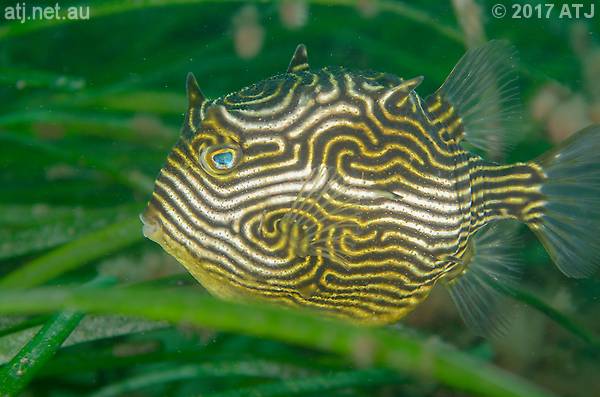
Ornate cowfish, Aracana ornata, at The Bluff Jetty on 1 September.
On the second dive at the same site, we went around the corner and along a slope that was dominated with kelp and sargassum weed. We saw two leafy seadragons: a juvenile which was missing part of its tail and an adult. They are truly beautiful fish.
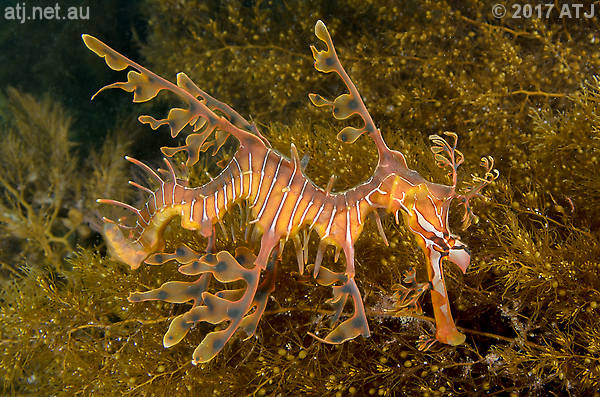
The juvenile leafy seadragon, Phycodurus eques, at The Bluff Jetty on 2 September.
The third day I dived alone as John was not feeling well from the cold water on the previous day. John was diving in a wetsuit. This time I went much farther hoping to come on some weedy seadragons which the dive shop had told us about. I didn't see any weedies but I did see more leafy seadragons, 8 or more.
I didn't see any seahorses or pygmy pipehorses but they are often seen in that area. I have an excuse to go back.
The only new locations for me were all the sites in Mexico and the site we dived in South Australia. All the rest of my diving was back at sites I dive regularly.
I did a dive at Shelly Beach, Manly in May to help Mandy Reid collect two reaper cuttlefish. I haven't dived at Shelly Beach in many years and it was fun to go back. We were buzzed by a small dusky whaler a number of times during the dive and I must go back there again during the whaler season.
It is not at all surprising that I saw saw some animals for the first time this year with my trips to Mexico and South Australia. It is surprising, however, that I again saw some animals in Sydney that I have never seen before. It is also amazing that I saw something new in nearly every month of the year. December is the only month where I saw nothing new.
In January I saw a yellow crested weedfish, Cristiceps aurantiacus. Actually I saw, two. I can't be sure I have never seen one before but I know I haven't photographed one. I was diving at The Leap on 19 January when I saw one at the start of Seadragon Alley. I tried to take photographs but it was too quick and the surge made it impossible to get a photograph. Later on the same dive, I saw another one just after the end of Seadragon Alley. It was bouncing around in kelp and was a lot slower. I managed to get a few photographs.
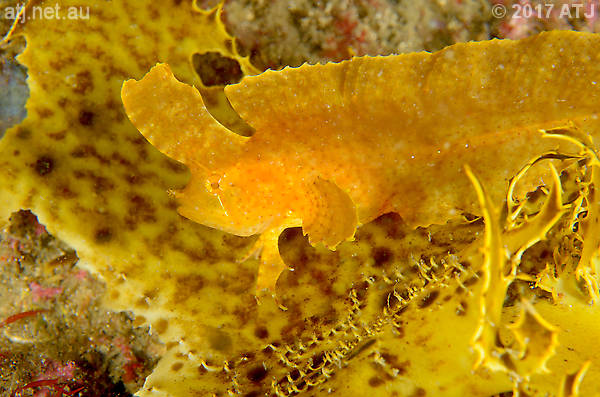
Yellow crested weedfish, Cristiceps aurantiacus, at The Leap on 19 January.
We see ornate and robust ghostpipefish in Sydney on a regular basis, especially at Kurnell. In February while diving at The Leap I came across what I thought was a pink robust ghostpipefish. I took lots of photographs but on examining the photographs I realised it wasn't a robust. After checking Kuiter (2009) I found that I had seen a delicate ghostpipefish, Solenostomas leptosoma. Rudie includes some pictures from Sydney so they have been seen here before. What is interesting is a search online reveals very few photographs so it appears they are quite rare anywhere.
I saw the delicate ghostpipefish again over the next few dives at The Leap but a week later it was gone.
I logged my sighting on iNaturalist. There are only two sightings there now. Eventually might sighting got pulled into Atlas of Living Australia and it is the one and only sighting (as the other sighting on iNaturalist was outside Australian waters).
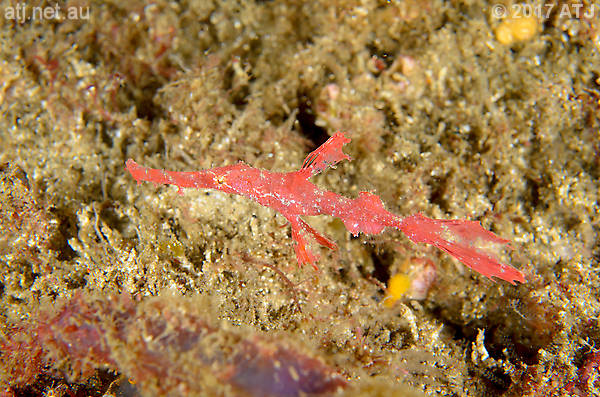
Delicate ghostpipefish, Solenostomas leptosoma, at The Leap on 1 February.
In March, just after I got back from Mexico, I was diving at Clifton Gardens when I spotted a juvenile yellowmargin triggerfish, Pseudobalistes flavimarginatus. I have seen quite a few different species of triggerfish as juveniles in Sydney but never this species. Rudie used to see them often in the 70s and 80s but I never had, until this one.
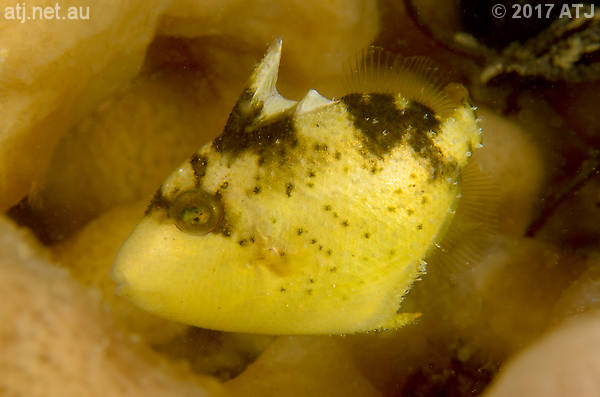
Juvenile yellowmargin triggerfish, Pseudobalistes flavimarginatus, at Clifton Gardens on 11 March 2017.
In April, my dive buddies showed me two golden egg cowries, Ovula costellata, in Capnella colonies at The Monument. I have seen the regular egg cowries, Ovula ovum, in the tropics a few times but never this species.
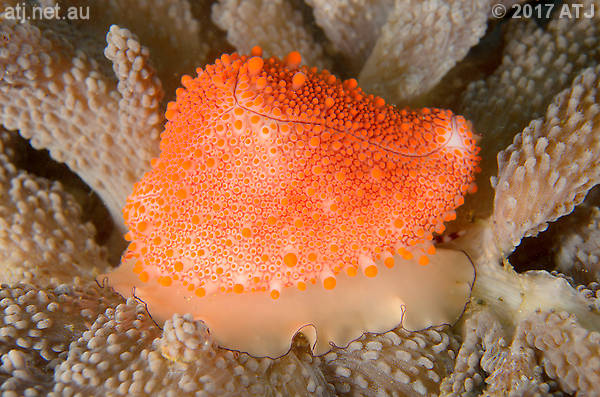
Golden egg cowrie, Ovula costellata, at The Monument.
In May, I found my first Red widebody pipefish, Stigmatopora sp., at Kurnell. I have since seen at least 7 others, including 3 pairs. I had been looking for them for a few years and was so pleased to finally find them.

A red widebody pipefish, Stigmatopora, at Kurnell in May.
While diving at The Steps in June, my dive buddy, Roney, spotted the tail of a pipefish in the algae. When we had a closer a look we saw that it was a red pipefish, Notiocampus ruber. I have wanted to see one of these for years and I finally got to see one. I was only able to take a few photographs before it disappeared.
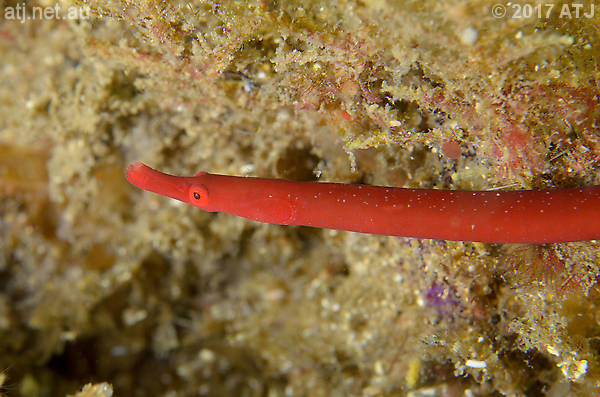
The red pipefish, Notiocampus ruber, at The Steps on 2 June.
Over the years I have see a few seamoths. Seamoths belong to a small family (Pegasidae) which is in a sister order to Syngnathiformes (the order of seahorses and their allies). All the ones I'd seen had been the slender seamoth, Pegasus volitans.
At the end of July I was diving with Dama, a dive buddy, when she spotted a little dragonfish, Eurypegasus draconis, at The Monument. It was so cool and so easy to photograph. We saw it in the same area over a few months and I took many photos and videos of it.
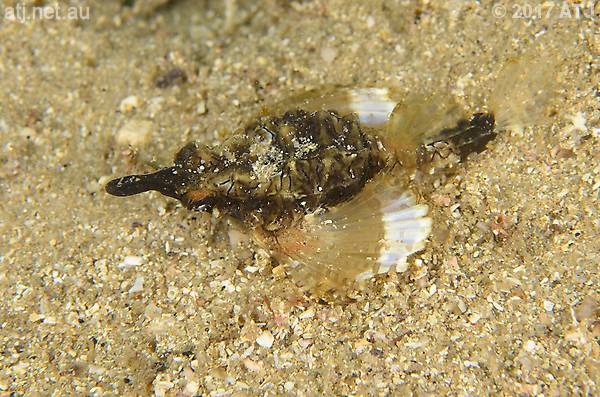
Little dragonfish, Eurypegasus draconis, at The Monument on 30 July.
Little dragonfish.
In August, I spotted a few Armina papilata nudibranchs at Clifton Gardens. I have never seen any nudibranchs in that family before, let alone the genus.
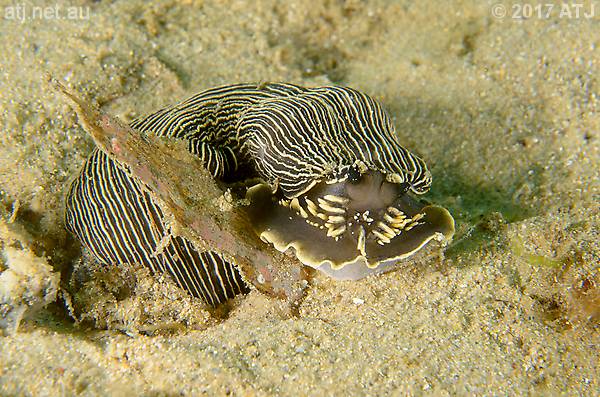
Nudibranch, Armina papilata, at Clifton Gardens on 19 August.
I was diving at The Leap in November when I spotted two wrapper anemones on a southern sea fan, Sphaerokodisis australis. I sent photographs to our marine invertebrates expert at the Museum and he sent them on to some anemone experts. It appears they are undescribed and can't even tell me a genus. I was asked to collect them but they were gone the next time I dived The Leap two weeks later.
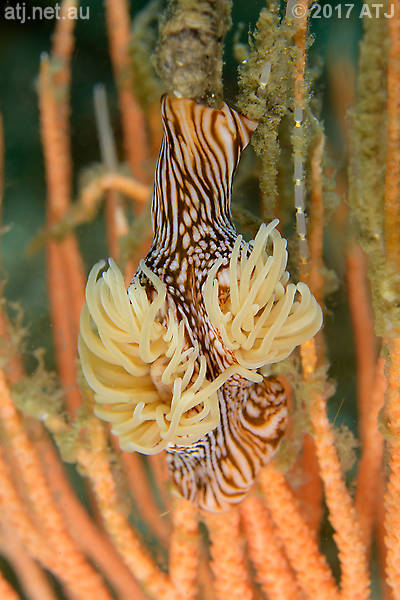
Wrapper anemones on southern sea fan, Sphaerokodisis australis, at The Leap on 29 November 2017.
Notable Sightings
Just like 2016, 2017 was a great year for anglerfishes. There were many juvenile painted anglerfish around in Sydney in 2017, as well as a many of red-fingered anglers in various colour morphs.
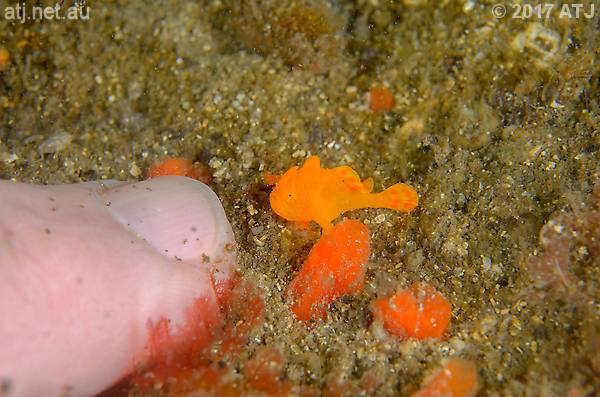
The tiny painted anglerfish, Antennarius pictus, at Bare Island, with the tip of my finger for scale.
I saw a number of different individual painted anglerfish, Antennarius pictus, at Kurnell, ranging from only a centimetre or 2 to 30mm. There were black ones and orange ones and most I saw on multiple occasions. I saw a number of orange ones at Bare Island.

One of the black painted anglerfish, Antennarius pictus, at Kurnell.
I saw a large number of red-fingered anglerfish, Porophryne erythrodactylus, at Kurnell over the year, and in a wide range of colour morphs, including grey, orange, yellow, pink and white/pink. Sometimes we'd see up to 5 on one dive.

A well camouflaged red-fingered anglerfish, Porophryne erythrodactylus, at Kurnell.
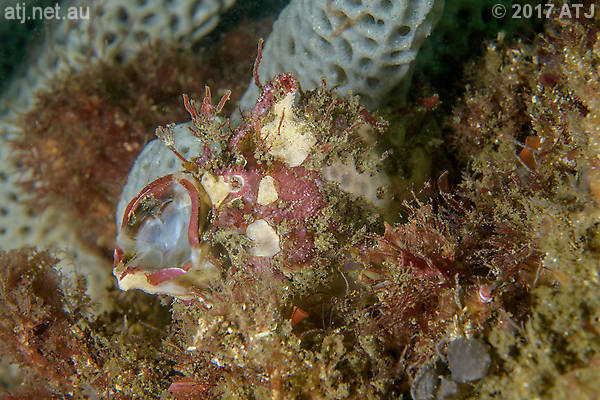
One of the white/pink red-fingered anglerfish, Porophryne erythrodactylus, at Kurnell.
There were a few striped anglerfish, Antennarius striatus, around, too, at Bare Island, Camp Cove, Clifton Gardens and Kurnell.
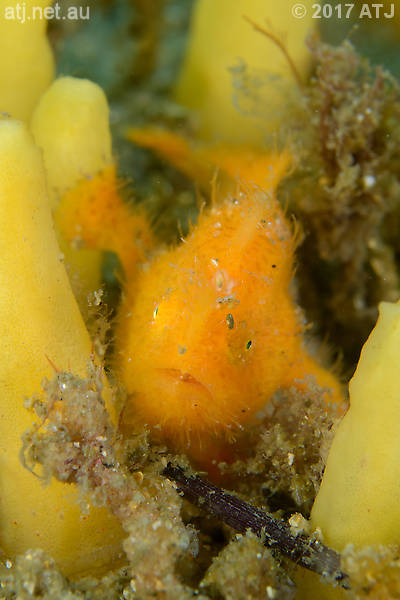
A striped anglerfish, Antennarius striatus, at Bare Island.
The year was mixed for syngnathids. After previous years of seeing 10 or more pot-bellied seahorses, Hippocampus abdominalis, I only saw 2 in 2017, a male ("Roney") in February and a female ("Sunshine") in October and November. The female may still be around but I haven't dived The Monument since November. At least one other male pot-bellied seahorse was seen at Kurnell but I didn't get to see it. There was a report of a pot-bellied seahorse at Bare Island.
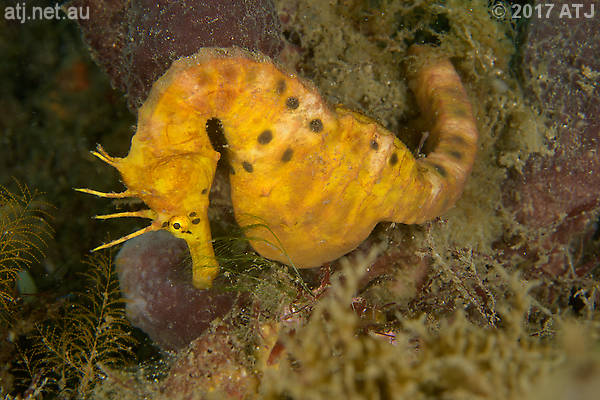
"Sunshine", the female pot-bellied seahorse, Hippocampus abdominalis, on 28 October.
The great seahorses, Hippocampus kelloggi were around at Bare Island for two thirds of the year but they eventually disappeared, the female first and then the male. On 15 October, at around the same time as the female disappeared from Bare Island, Dama, a dive buddy, spotted a female at Kurnell. I got to see her on 18 October and have seen her on every dive at The Leap (and some dives at The Steps) since. It is possible it is the same female from Bare Island but I have compared my last photograph of the one at Bare Island to my first photograph of the one at Kurnell and they appear to be different individuals.
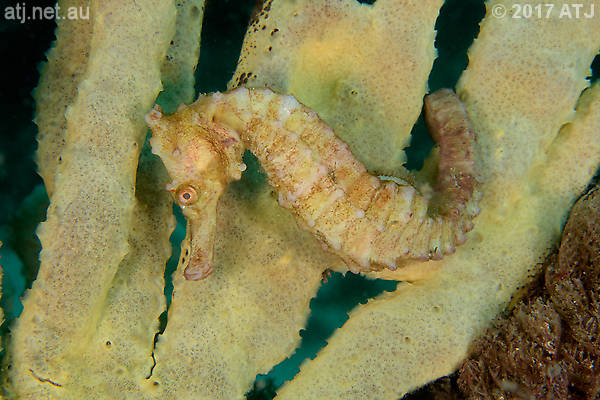
The female great seahorse, Hippocampus kelloggi, on 10 December at Kurnell.
There were even a number of White's seahorses, Hippocampus whitei, at Kurnell and Bare Island during the year. There was a pair at The Monument we saw on a regular basis as well as some individuals at The Monument and even The Steps we saw on occasion.
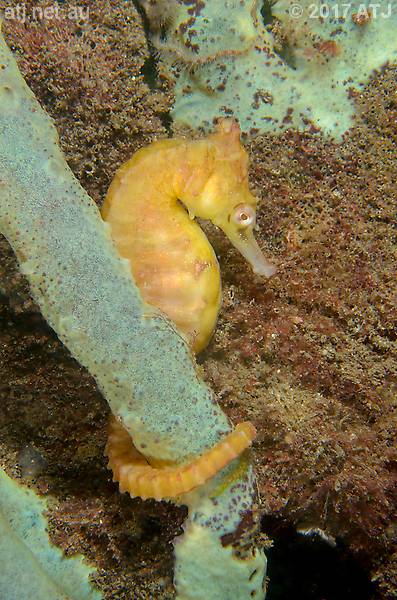
A White's seahorses, Hippocampus whitei, on 30 January at Kurnell.
The numbers of weedy seadragons, Phyllopteryx taeniolatus at Kurnell is still down from before the storm last year. There were quite a few male weedies with eggs so hopefully the population will bounce back.
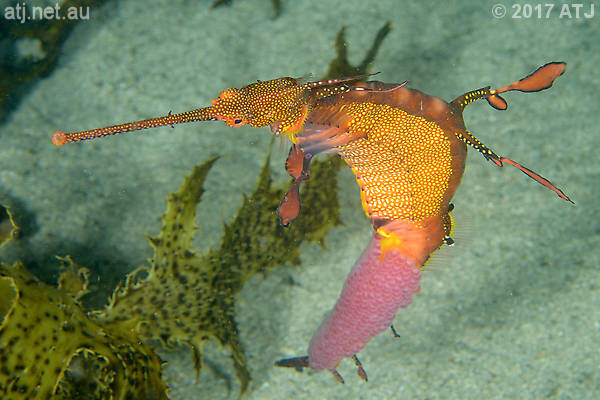
A heavily laden male weedy seadragon, Phyllopteryx taeniolatus at The Leap.
I saw many pygmy pipehorses, Idiotropiscis lumnitzeri, at Kurnell over the year: probably more than any other year. I haven't had a chance to analyse my data but seeing as many as 19 on a single dive suggests a lot of pygmy pipehorses. Many I spotted myself but I'm now diving with a few people who are also spotting them which is probably why I am seeing more. I suspect there are many that I am not seeing. I know I can look at a rock for over 5 minutes to find a pygmy pipehorse I know is there. How many do I miss because I don't spend the time looking?
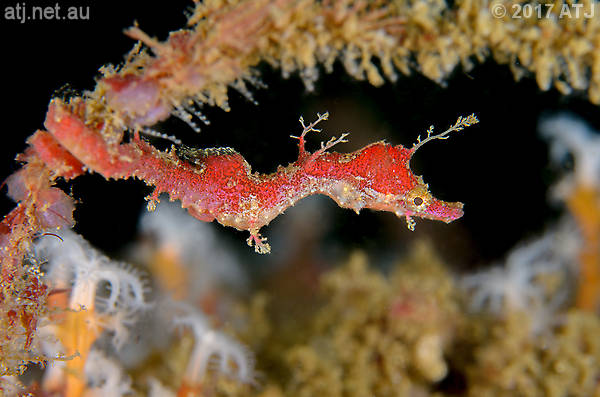
A male pygmy pipehorse, Idiotropiscis lumnitzeri, at The Monument in April, one of many I saw in 2017.
In addition to the red widebody pipefish and the red pipefish I saw a number of other pipefish which I have seen before including a javelin pipefish, Lissocampus runa, in February (spotted by my dive buddy, Mike), tiger pipefish, Filicampus tigris, at Camp Cove and Clifton Gardens, and a number of girdled pipefish, Festucalex cinctus, at Kurnell and Clifton Gardens.

The javelin pipefish, Lissocampus runa, at The Leap on 18 February.
This year was another good year for ghostpipefishes. I don't think I saw as many different individuals as last year but the ones we saw seemed to hang around for longer. The delicate ghostpipefish, Solenostomas leptosoma, (as mentioned above) was probably the best sighting but I also saw a number of robust, Solenostomus cyanopterus and ornate, Solenostomus paradoxus, ghostpipefishes at Kurnell.
In February, my dive buddy, Roney, spotted a beautiful robust ghostpipefish between The Steps and The Monument. It's beauty was trumped by a green male in a pair I saw at The Leap in May.

The pair of robust ghostpipefish, Solenostomus cyanopterus, I saw at The Leap in May.
We saw a pair of ornate ghostpipefish at The Monument over a number of weeks from May and then in June a beautiful pair turned up near Big Rock (between The Leap and The Steps).
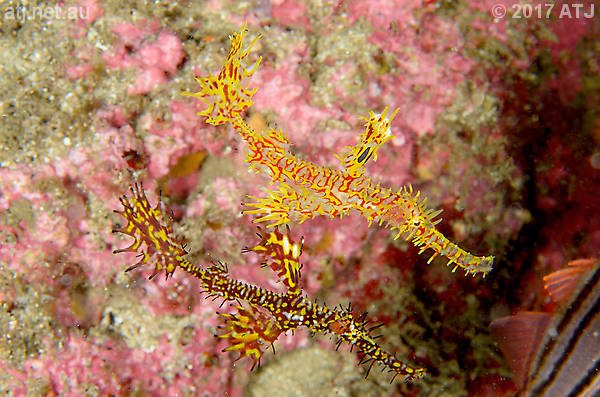
A pair of ornate ghostpipefish, Solenostomus paradoxus, near Big Rock, Kurnell in June.
There are a number of species of scorpionfishes that are seen regularly around Sydney but this year I was very surprised when my dive buddy, Daniela, pointed out a leaf scorpionfish, Taenianotus triacanthus, at The Monument in August. The Australian Museum has two records from 1975 (incidentally, they were found by Rudie Kuiter and John Meredith) from Watsons Bay but no records from as far south as Botany Bay. I saw the leaf scorpionfish again a few days later.
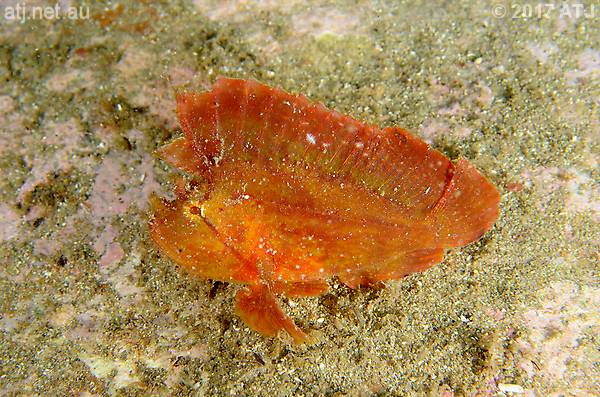
The leaf scorpionfish, Taenianotus triacanthus, at The Monument in August.
I have seen zebra lionfish, Dendrochirus zebra, before in Sydney but they are not all that common so I was surprised to see one so small in September near Little Big Rock at The Steps. Normally we'd see juveniles like this much earlier in the year.
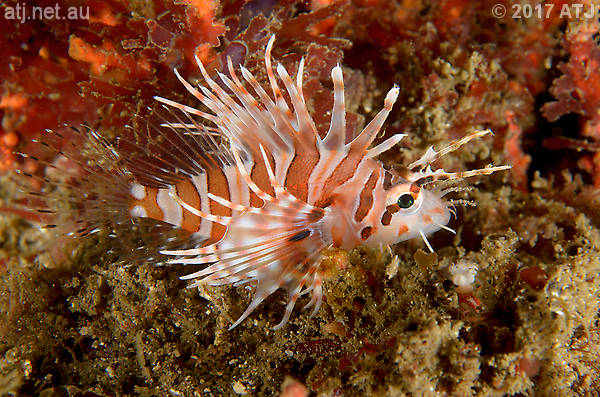
The juvenile zebra lionfish, Dendrochirus zebra, at The Steps in September.
Like 2016, 2017 was an interesting year for nudibranchs. There were some Miamira magnifica around with at least 2 near The Steps with one of them being tiny.

A tiny Miamira magnifica nudibranch, with my finger for scale.
In May, I found a Ardeadoris rubroannulata between The Leap and The Steps. There were also a couple at Bare Island.

Nudibranch, Ardeadoris rubroannulata, at Kurnell in May.
There were a few Okenia melita spotted throughout the year.
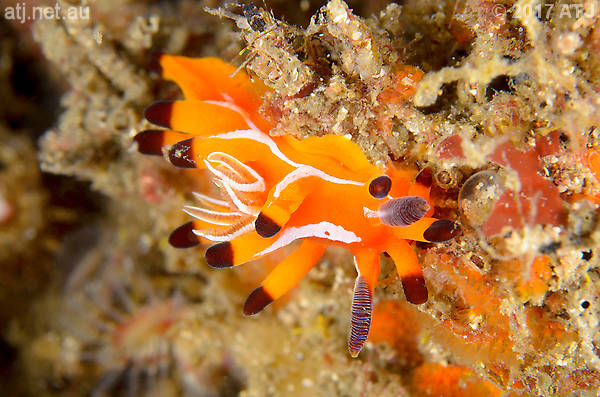
Nudibranch, Okenia melita, at Kurnell in January.
Nembrotha purpureolineata have become quite common now at Kurnell and it is rare that I don't see at least one per dive.

Nudibranch, Nembrotha purpureolineata, at Kurnell in November.
There has also been a Nembrotha sp. around for most of the year.

Nudibranch, Nembrotha sp., at Kurnell in July.
I saw a few Ceratosoma brevicaudatum throughout the year at Kurnell.
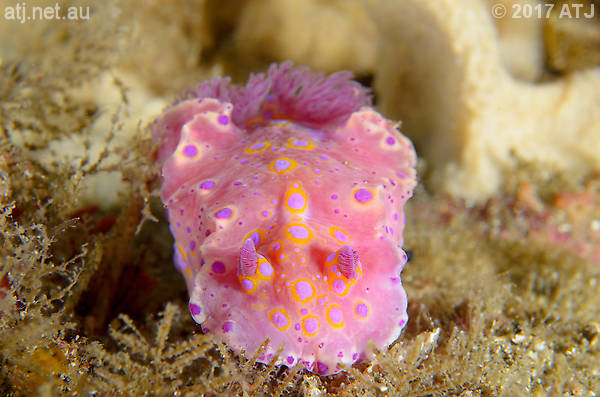
Nudibranch, Ceratosoma brevicaudatum, at Kurnell in July.
There were a few Tambja verconis around at Kurnell this year.

Nudibranch, Tambja verconis, at The Leap in June.
I would like to thank all my dive buddies from 2017: Aiden, Alex, Brett, Chris, Cody, Daniela, Dama, Dave, Donna, Dom, Fabio, Gary, Garry, George, Graham, Heather, Igor, Jeroen, John, John, Karen, Kim, Kyle, Lou, Lena, Malcolm, Mandy, Mandy, Mark, Martin, Mic, Michael, Mike, Nicolas, Paula, Peter, Robert, Ron, Roney, Rudolf, Scot, Sean, Sheree, Steve, Steve, Sue, Tony, Trevor, Versnar. You showed me things, you let me show you things, you shared my dives with me and I am grateful.
It is not easy to predict the future but I hope 2018 will be another fun year of diving. I have no dive trips planned but I may do a road trip to South Australia in February to see more leafy seadragons and hopefully see some short-head seahorses and maybe some southern pygmy pipehorses. I'm happy to continue diving in Sydney as there is always something cool to see.
I'm looking forward to an exciting 2018.
Kuiter R.H. 2009. Seahorses And Their Relatives. Aquatic Photographics, Seaford. 334pp.
Last updated: 31 December 2017